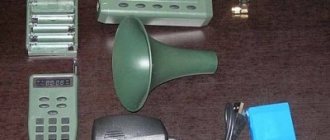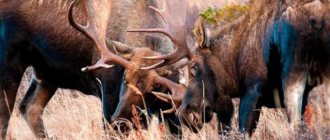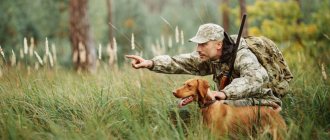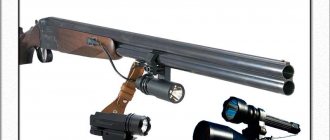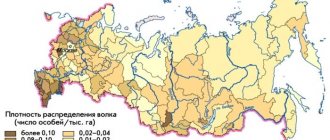A weak shooter should not shoot a large animal from the front: its killing area here is small; Having hit the skull or shoulder blade casually, the bullet easily slides off without affecting the internal organs of the animal. Shooting a large animal from behind is also considered reprehensible: even if it is seriously wounded, it goes far, suffers for a long time and often disappears for the hunter.
Diagram and explanation of elk slaughter areas
When shooting an elk with a powerful 9 mm rifled weapon or a smooth-bore weapon with a heavy lead bullet, one can hope for a high stopping effect of this weapon. And such a shot in the chest area will certainly provide you with prey. But you shouldn’t completely rely on this, especially if you have a weapon of less power.
Moose slaughter places: 1 – the most slaughter places, 2, 3, 4 – less productive areas for shooting
Moose slaughter areas can be distributed as follows:
- Neck
– important blood vessels and cervical vertebrae are located in it. Hitting them will certainly lead to stopping the beast without any options. The neck should be considered a good killing spot, but it is not always possible to hit it. - The chest area
- a hit along the lower edge of the shoulder blades, where the heart is located, stops the elk, if not on the spot (remember about its strength on the wound), then within the next five minutes. A shot in the ribs that hits the lungs will also bring you a trophy, which you'll have to run around for a bit. It is better not to chase a wounded elk right away; let him lie down and feel safe. In an hour it will be much easier to find the wounded animal. If we talk about shooting an elk coming straight at you, then you should shoot exactly in the center of the chest. - The head
– or rather the brain. When shooting at the brain, do not forget about its small size relative to the entire head of the elk, as well as the powerful bones of the skull. This requires precise sniper shooting, but such a hit will stop even a powerful bull in its tracks.
And in conclusion, a few words about safety measures: it is correct to approach a lying elk from the back and with a loaded gun; there are often cases when an animal that seems to have reached its limit suddenly jumps up and leaves.
When approaching, pay attention to the animal’s ears and tongue
: ears pressed to the head is a sign that the elk is still alive and you should not let go of the smoothbore. But a fallen and bitten tongue, on the contrary, indicates that the elk is ready. Knowing the killing areas of elk and having some luck, you can always count on catch.
How to determine the severity of an injury
The senior gives the command “Hang up.” Now the shooting site can be examined to determine how seriously the elk is injured and whether it is injured at all.
- Blood, naturally, is the first sign of a hit. But this is not the only “beacon”. Long tufts of hair where the elk is located during the shot
indicate a hit in the upper part of its body, and short, light-colored tufts indicate a hit on the legs. - Dark blood and not enough of it
. Most often, this indicates a wound to the chest; Most likely, the bullet hit internal organs and remained in the body. With such a wound, the elk walks heavily and tries to lift part of its body. - The intestinal wound makes the animal hunched over, there is little blood, dark, and sometimes even black, in color
. - Blood lying on both sides of the mark
characterizes the wound as through. - Dark, liquefied pieces of blood
indicate that the wound is very severe and is associated with damage to internal organs.
A wounded animal often tries to cool the wound and gain strength. For this purpose it lies down. The severity of the injury can also be determined from the traces left at the place where it was lying.
Attention should also be paid to objects located on the elk’s path. So, bloody spruce branches and bushes can show the height at which the wound is located.
The beast leaves other traces
, to decipher them you just need to look around carefully and not rush to conclusions and persecution.
Even a seriously wounded moose can wander far if it feels pursued. Therefore, it is better to wait about an hour. You can walk either along the trail itself or outside of it, cutting off the trajectory.
Shooting rules
Moose hunting is dangerous
. This is a strong beast weighing up to half a ton, which, when frightened or wounded, can rush at a hunter. He is physically strong and covers long distances. Therefore, it is customary to go to the forest giant in a group. If a moose hunt is planned, each member of the hunting group should know the killing places.
When hunting elk, there is an unshakable rule for roundups: the animal cannot be shot if the elk is moving past the shooter in the distance, but directly at the neighboring hunter. If a moose appears in your field of vision, do not immediately raise your gun.
It’s better to let the elk aim for the right shot and only then smoothly take aim, aiming accurately, and shoot. Often the appearance of such a large animal as a moose makes the hunter so excited that he shoots without aiming, as if offhand. By the way, this is typical for many inexperienced hunters.
Only after a dozen elk have been taken will the hunter shoot calmly and accurately.
If the place is empty, and the animal flashes between bushes and trees in clearings, it is more advisable to immediately take the elk at gunpoint and accompany it with the barrels to the clearing in which it is decided to shoot it.
When hunting elk, the killing place is selected based on the distance to the target, the type of gun the hunter has and the ammunition used.
But there is a universal rule - you should not shoot an elk further than 50 steps (approximately 35 meters) with a shotgun.
Elk is very strong when wounded
.
There are a large, reliable number of cases where elk were killed at long distances, but at the same time even more wounded animals were made, most of which were lost, useless to hunters.
Like all ungulates, the neck is a very killing place for an elk. Many reference books and manuals recommend shooting at the neck
, because there are nerves on the sides, and the brain is inside the vertebrae.
The cervical vertebrae are very large, large processes are formed on them. The muscles attached to them help the males bear heavy antlers.
In addition, large blood vessels (the jugular vein along with the carotid artery) and large nerve trunks pass through the neck.
Therefore, you can shoot at the neck from a long distance, but always with a rifled weapon
. Besides the neck, there are other killing areas for elk.
For example, when shooting further than 15-25 steps, it is better to aim at the lower edge of the shoulder blades
, that is, to the place where the heart is located.
Even if the bullets do not hit the heart, if fired successfully they will still cause a serious wound. Naturally, an elk cannot withstand a precise hit to the brain
.
Share link:
Boar shooting technique
To hit a running animal and hit its killing spots, it is important to follow the rules of shooting at a moving target. The main one is compliance with anticipation. In this case, aiming and shooting are carried out slightly ahead of the killing point.
Depending on the type of weapon, the distance to the animal and the speed of its movement, the amount of lead may be different. But the general calculation rules stipulate that when running at an average speed (10 km/h), you need to fire a shot at a distance of about 50 m 0.7-1.4 m ahead of the target (the values are indicated for a rifled and smooth-bore gun, respectively).
With a smaller distance to the target and the running speed of the beast, the numbers decrease. For clarity, it is often recommended to shoot at a boar while aiming at the heart, moving the sight to the tip of its snout.
It is best to watch for a wild boar during a solo hunt along the path along which it goes to feed. They go to ambush before sunset, and after dusk the wild boars begin to move. At this time, you can calmly target the killing spots of the selected animal: there is still enough light, and the animal behaves calmly.
Driven hunting is carried out by a large group. Shoot the boars after choosing a target, and do not try to hit animals that are at an angle of less than 40 to the line of shooters. When the release command sounds, stop shooting and unload the gun so as not to create a threat to the approaching beaters.
Behavior of a boar after a shot
Beginner hunters are not recommended to fire shots when the cleaver comes out in front of the hunter. After an unsuccessful shot, the animal will run in a straight line and is capable of rushing at the hunter. It is best to target prey in a side position: there is an opportunity to hit the heart. A shot at an angle, at the base of the neck, will also be successful.
When aiming at the brain and making a successful hit, the wounded animal falls and struggles, moving its legs randomly. You should not immediately approach him: if he is only stunned, then after a few seconds he can get up and rush at the hunter. If he does not see a person, he will quickly run away. It is impossible to catch up with and catch such a wounded animal.
When the spine is damaged, the cleaver assumes a sitting position, falls and tries to rise to its front legs, but is unable to move. The animal must be finished off with a sure shot to the head.
When aiming at the heart, you should try to hear the sound of the bullet when it hits: a ringing sound indicates a hit in the rib or scapula and may indicate effectiveness. Most often, such a boar continues to run and is able to go 150-400 m.
Where to shoot elk for effective hunting?
When hunting a large game, it is important to make an effective shot, which is likely to be fatal. Knowing the killing spots of an elk, the hunter will not only be able to catch it without a long pursuit - sometimes the life of the person himself depends on a correctly fired shot.
Diagram and explanation of elk slaughter areas
Knowing the anatomy of the animal helps you make a successful shot. The surest hit is in the heart or neck of the elk, but vital areas can only be hit if you aim at the right places. The description of slaughter places is explained by the following diagram:
The spine is also considered a good killing site. When hit slightly behind the withers, the elk loses strength and lies down within 10-20 minutes. With such a shot, lungs or large vessels can be hit, and vertebrae can be crushed.
When shooting from the side on the right, when it is not possible to hit the animal in the heart, the best shot may be a hit in the head. Aiming is done at a point that lies midway between the base of the ear and the eye.
It is quite difficult to make an effective shot, because the moose’s brain is small, and if aimed incorrectly, the bullet will hit the thick bones of the skull. You should only shoot in the head if you are completely confident in your accuracy.
In addition to the best killing points, a shot can be fired at secondary ones (both right and left):
- throat - in front of the anterior edge of the shoulder blade, above the convex part of the chest;
- lungs - the sides of the animal to approximately the middle of the body;
- belly - from the middle of the body to the hind leg.
If the elk comes under fire in such a way that you can only shoot from the front, aim exactly at the center of the chest, where it meets the neck. Large arteries are located here, and when damaged, the animal quickly loses a critical amount of blood.
Bullets on a boar
The success of boar hunting also depends on the type of bullet used. It should be noted right away that such a bullet for a 12-gauge smoothbore weapon must weigh no less than 32 grams. For example, the Tandem bullet shows good accuracy when shooting at long distances. At short and medium distances, many hunters recommend using modifications of the Polev bullet.
When hunting young wild boars, you can also use buckshot, but it should be taken into account that the shooting distance should not exceed 30 meters due to the lower killing power and the large spread of shot when shooting at long distances.
Moose hunting
An elk is a valuable trophy, but acquiring one will require a lot of effort. Sometimes, inexperienced hunters do not quite understand what awaits them and what they have to do.
Content
How to shoot a moose
Shooting in general, and especially at large animals, requires both filigree precision and knowledge of slaughter areas, as well as emotional control. After all, if the hunt is collective, then the shooter bears a certain responsibility to other like-minded people. And sometimes it is difficult for even a seasoned hunter to cope with such a load.
Therefore, haste is good when catching fleas. And when hunting elk, you need to evaluate and weigh every decision. The beast must be allowed to take a 100% killing shot (if, of course, this is possible).
If branches or something else interfere with aiming, then it is better not to tear off the trigger pod. And you can't be greedy. If the elk went to the next number, then let him go. A “warm welcome” has already been prepared for him there.
By making a hasty, inaccurate shot, you can send the animal in the wrong direction. Not to mention breaking the rules and hunting ethics.
Degree of injury
You can tell how badly an elk is injured by its behavior and tracks. It is important to remember here that you cannot immediately rush after a wounded animal. You need to wait about thirty minutes. Experienced huntsmen even advise “smoking” for an hour. And only after that go in search of the beast.
You can hurry only under one condition - nightfall. Why wait so long? It's simple: a wounded animal will understand perfectly well that he is being pursued.
Therefore, he will fight for his life to the end and may go very far, or hide in such jungles that he would never have ventured into in a healthy state.
Therefore, first you need to carefully examine the shooting site. If, in addition to blood, there are also shreds of fur, then the shot hit the target. If the hair is long, then the bullet hit the upper part of the body. And if it’s short and light, it’s perfect.
You can tell that the wound was to the legs by the blood. There is usually a lot of it and it is red. True, there is a nuance. A wounded animal can lie down abruptly, and then jump up and move quite quickly.
If the bullet passes through the chest, but not all the way through, hitting the organs, then the animal raises the front part of the body and walks heavily. There is little blood and it is dark in color.
When a bullet hits the intestines, the elk humps. There is little blood, it is almost black and often contains digested food.
- It is not difficult to understand that the wound is through – there is blood on both sides of the animal’s track.
- If blood is found throughout the mark in the form of dark pieces, it means that the wound is very serious and the discharge occurs through the throat.
- A wounded elk often lies down to gain strength and cool the wound.
Slaughter places
In order for the elk to remain in place after the shot, the bullet needs to hit the slaughter area.
There is another option - the weapon must be of such a caliber, and the charge must have an ultra-high stopping effect, so that the animal receives a shock. During this time, he can be finished off with a second, more accurate shot.
Usually these are rifled guns from 9 gauge. To prevent the elk from taking a single step (or not going far) after the shot, you need to aim:
- Under the shoulder blade. And even if the bullet does not hit the heart, it will cause severe damage. The elk may try to escape, using all the resources of the body; it will not be able to fight for life for long.
- A shot in the neck may be successful, but it is difficult to hit it.
- A shot to the spine or brain is considered ideal. But the spine is difficult to hit because of the high mane, and the brain is too small. In addition, there is a possibility that the bullet will simply ricochet off the skull. You should only shoot at the head or ridge with a powerful and high-precision weapon from a short distance. And this, as you might guess, can be dangerous to the health or life of the shooter himself. Whether such experiments are needed or not, each hunter decides for himself.
Where to shoot an elk with a smoothbore to kill it. Where to shoot elk for effective hunting?
Elk is one of the largest animals in our country, and therefore is a desired trophy for every hunter. This is a very strong, hardy, wound-resistant animal that can cause a lot of trouble to an inexperienced hunter.
Very often, elk are hunted in large teams, so the shooter also bears responsibility to his comrades. If the shot is unsuccessful, the coveted trophy can not only go to someone else, but also force the whole team to run through the forest after a strong wounded animal.
That is why it is important to know where to shoot an elk and what weapon is best to do it.
Slaughter place diagram
The most killing places for moose are the same as for other large animals. They are:
1. Brain - like everyone else, its damage leads to instant death. An elk has a relatively small size, so when shooting at the head you need to aim:
- on the side - between the ear and eye;
- in front - between the eyes;
- from the side to the back - under the ear;
- from above to behind - between the ears.
When at the moose. General information, description of the moose
2. Spine - its defeat also leads to an instant stop of the beast. But the anatomy of an elk is such that when shooting from the side, the exact position of the spine is difficult to guess due to the mane and fatty mound.
Contact with the vertebral processes causes a short-term shock in the animal, but does not cause significant harm to the animal. An elk may fall, but after a few moments jump up and run as if nothing had happened.
Therefore, they shoot at the spine either from above, along the longitudinal axis of the animal’s body, or, if from the side, then in the middle of the back, on the palm below the deflection point, or in the neck.
3. The neck is a good killing zone on the body of an elk. In addition to the spine, it contains vital arteries that supply the brain and the trachea. Their defeat also leads to a quick stop of the animal. The elk's neck is well defined; you need to aim at its middle.
4. Heart - hitting it often does not lead to the instant fall of this animal, but death when it is defeated occurs very quickly and the elk usually does not have time to escape.
The heart is located on a line behind the front leg in the lower third of the body. You need to aim just behind the front shoulder blade.
From the front, to defeat it, they shoot at the base of the neck, from the rear hemisphere - under the front shoulder blade, the further away from it, the sharper the aiming angle.
5. Lungs - getting into them, in most cases leads to the death of the animal, but with such a wound the elk can go a fairly long distance. The aiming zone when shooting from the side is in the area of the front shoulder blade on the line of the middle of the body.
6. Other internal organs - liver, stomach, intestines, etc. are not such killer zones as those mentioned before. They are located in the abdominal area. Although their defeat ultimately leads to the death of the elk, it allows him to move for quite a long time.
Shooting elk with a smoothbore
Shooting a moose from a smoothbore gun is effective at distances of up to 50 -70 meters. This is a typical distance both for shooting from storage sheds and towers, and when hunting in the forest. Smoothbore shotguns with a long barrel length are usually used for moose. Let's consider what is better to shoot at this beast.
According to the rules of elk hunting, it is allowed to shoot only with a bullet. There is no consensus among hunters about the most suitable ammunition, so everyone chooses what suits him specifically. We will look at the most commonly used and proven bullet options.
Polev's bullet
Very popular among many hunters of large ungulates. Shows consistent, predictable results when shooting elk. It has good accuracy and penetrating ability. And Polev 6 bullets, thanks to their improved design, while maintaining ballistic characteristics, also have a good stopping effect.
Brenneke bullet
Another popular ammunition among large game hunters. This is a powerful, heavy bullet that performs well at distances up to 50 meters. It has great stopping power and penetration ability. But at long distances its accuracy suffers.
Gualandi bullet
Also popular ammunition for shooting elk and wild boar. It works great at distances up to 60 m. And the model with a weight of 40 g has an excellent stopping effect; at 50 meters its lethality is comparable to a 9.3 mm rifled shot.
McElvin's bullet
Among a number of Experts it is considered ideal for moose hunting. This is not surprising, since it was originally developed for hunting this animal. It is one of the best in terms of accuracy and precision of combat, flat trajectory and penetrating action.
